One of the biggest allures of investing in rental properties stems from decreasing an individual’s taxable income through rental property depreciation.
As we all know, building wear and tear has real costs. As structures wear out over time, the usable life and value of that property decreases. Those decreases can be accounted for using the IRS’ depreciation guidelines.
For savvy real estate investors and landlords, accounting for a rental asset’s decreased usability minimizes tax liability by shrinking taxable income. If done right, landlords can keep more money in their bank accounts.
However, accounting for depreciation costs, while a wise financial move, can be a time-consuming and complex process. With that in mind, we’ll examine rental property depreciation, how to calculate it, and some tools investors can use to alleviate stress during tax season.
NOW 50% OFF! Tax Season Special on Accounting
Set your business up for success. TurboTenant users who subscribe to our rental property accounting software get 50% off their first two months.
Are you an existing TurboTenant user? Log in here to claim your discount.
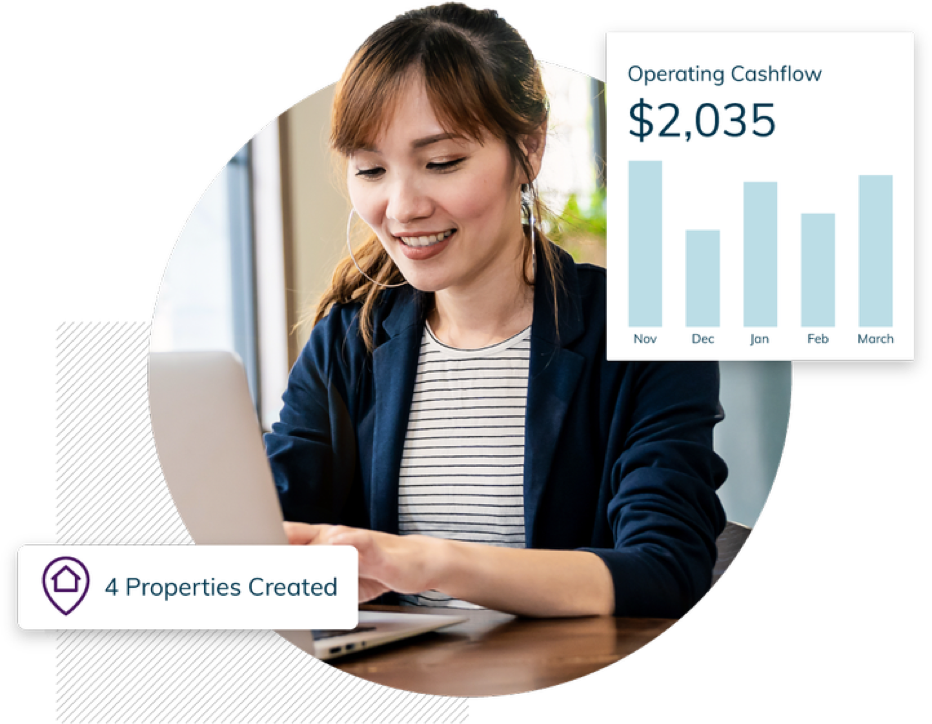
What is rental property depreciation?
Rental property depreciation is a tax law concept that allows rental property owners to deduct a portion of the cost of a property and any improvements they make over a set period, generally 27.5 years, as defined by the General Depreciation System (GDS), which we discuss in further detail below.
The total number of years, 27.5, represents a key figure because that’s what the IRS deems as the usable life of a residential rental property when using GDS. Instead of taking one large deduction for the entire cost of the property in the year you buy it, depreciation allows investors to deduct a smaller amount each year to account for wear and tear.
Note: While GDS is the most widely used system, the IRS also employs the Alternative Depreciation System (ADS), which we explain in our Calculating Depreciation section.
Is your property a depreciable asset?
Your property must meet four essential criteria to be eligible for depreciation based on IRS guidelines.
- Landlords and real estate investors must own the property, and they’re still considered the owners if they owe on it.
- Investors must use the property to generate income.
- The property must have a “determinable useful life.” The IRS defines properties as having a useful life if they can “wear out, decay, get used up, become obsolete, or lose value from natural causes.”
- Investors can only claim depreciation on properties with a useful life of more than one year.
For properties that fit these parameters, investors can then determine how to calculate their depreciation values to factor into deductions.
Calculating Depreciation
When buying a new property, investors often face many challenges related to making it habitable or appealing to potential tenants. That could mean fixing broken fixtures, repairing structural components, or upgrading appliances. Once construction is done and marketing starts, the landlord can put the unit “in service.”
Suppose an investor purchases rental property on February 1, but it requires them to put some work into it, which delays advertising the property until March 15.
In this case, the in-service date would be March 15. Be aware that landlords can still depreciate the property from that date, even if they don’t have a tenant.
Now that you know when to begin depreciation, you must determine which depreciation system to use. Don’t worry — it’s not that hard.
Depreciation Methods
Investors whose rental properties were placed in service after 1986 will use the Modified Accelerated Cost Recovery System or MACRS.
MACRS uses two depreciation methods — the GDS and the ADS — which we briefly mentioned above. Let’s examine the two systems in more detail to determine how they apply to rental property depreciation tax accounting.
General Depreciation System
GDS is the most commonly used depreciation method, so investors will likely use it when depreciating their rental properties. It outlines some fundamental principles.
As previously explained, depreciation for residential rental properties is commonly spread over 27.5 years. In effect, this implies that investors and landlords can benefit from significant tax deductions at the early stages of ownership. Commercial properties, on the other hand, use a 39-year depreciation window.
Second, GDS primarily uses the straight-line method of depreciation. That means investors will always deduct the same amount from their taxable incomes based on the cost basis, which we discuss below.
While the straight-line method is the most commonly used, it isn’t the only one landlords can use in this system. Investors can also use the declining balance method, which allows for larger deductions in the early years.
Alternative Depreciation System
Fewer landlords will use ADS. The IRS stipulates that real estate investors and landlords must use the ADS rental property depreciation system if certain conditions are met, including:
- The property has a tax-exempt use
- The property uses tax-exempt bond financing
- The property is used primarily for farming
- The property is used for business purposes for 50% or less of the year
If your property fits those descriptions, you‘ll employ ADS. ADS uses a longer depreciation schedule of 30 years. This schedule lowers depreciation deductions and spreads them out over a longer period.
Keep in mind: Landlords and investors can opt to use ADS for their properties on a unit-by-unit basis, but once they select the ADS method, they cannot change it.
Check out the IRS documentation linked above for more information on either schedule.
Calculating Cost Basis
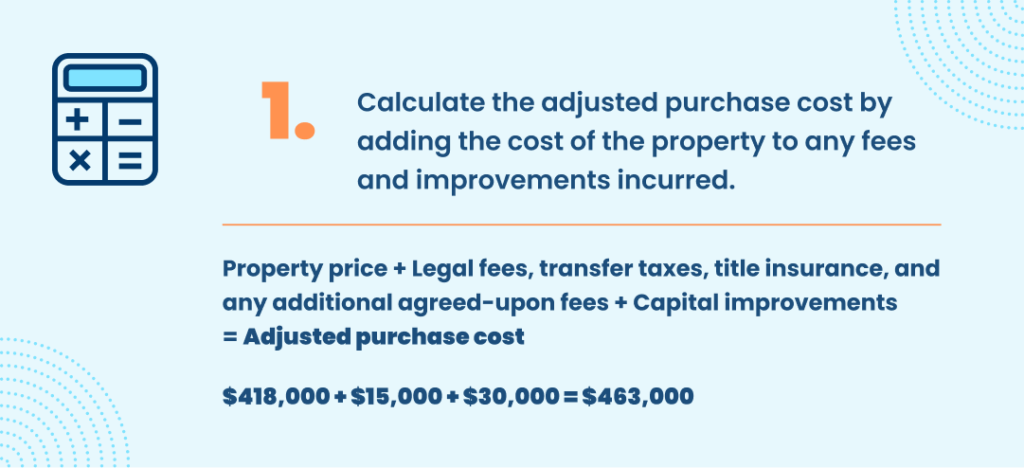
Now that we’ve specified which depreciation method applies to a given property, finding the cost basis of a property will give you all the information needed to determine the values you can deduct from your taxable income.
The first step is to determine the property’s cost. For example, say you find a property listed for $418,000. Often, that’s not the final price. You may need to add in settlement costs or fees directly incurred at the time of purchase, such as legal fees, transfer taxes, title insurance, and any additional fees you agree to pay. Let’s ascribe a value of $15,000. You capitalize or add these to your depreciable cost basis in the property.
Now, suppose you renovated the kitchen for $30,000 to make the property more appealing. You can add these costs to the basis to help offset the initial investment. In short, the total cost of acquiring the property and renovation is $463,000 ($418,000 property price + $15,000 in fees + $30,000 renovation).
You can’t depreciate the entire $463,000 because the building sits on land, and land can’t be depreciated. The IRS states that land has an indefinite use life, so you’ll subtract the land value from the total purchase price. When you segregate out the land cost and tally up the other values, you arrive at your depreciable cost basis. You’ll use this figure to calculate your depreciation expense each year.
Establishing Land Value
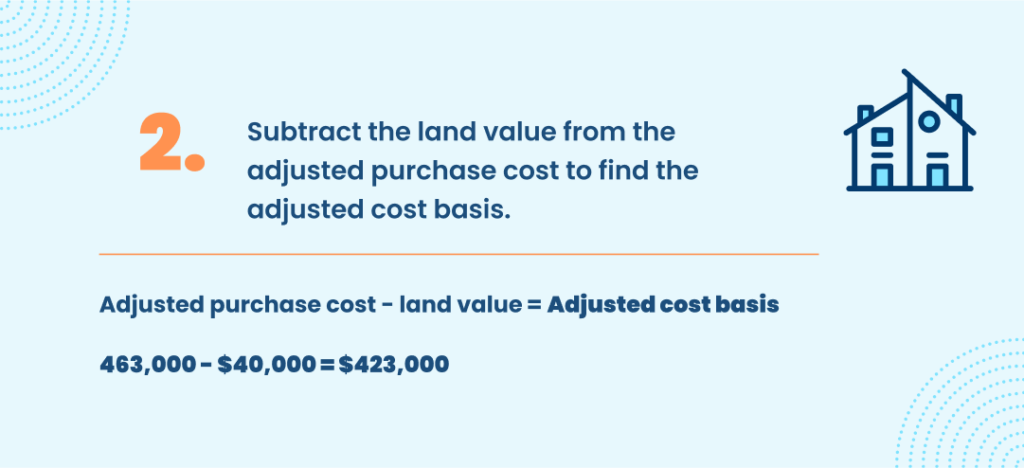
Investors can find the value of land from a number of sources to help in their rental property depreciation calculations, including:
- Property tax card or bill: Local governments often assess the value of the land and the building separately for property tax services. This information is readily available through your assessor’s website or office.
- Assessed values: Your property tax documentation should show the value assigned to the land and the building improvements separately.
- Professional appraiser consultation: Hiring an appraiser can help streamline the process and ensure a property appraisal if the tax assessment seems inaccurate.
Final Calculation
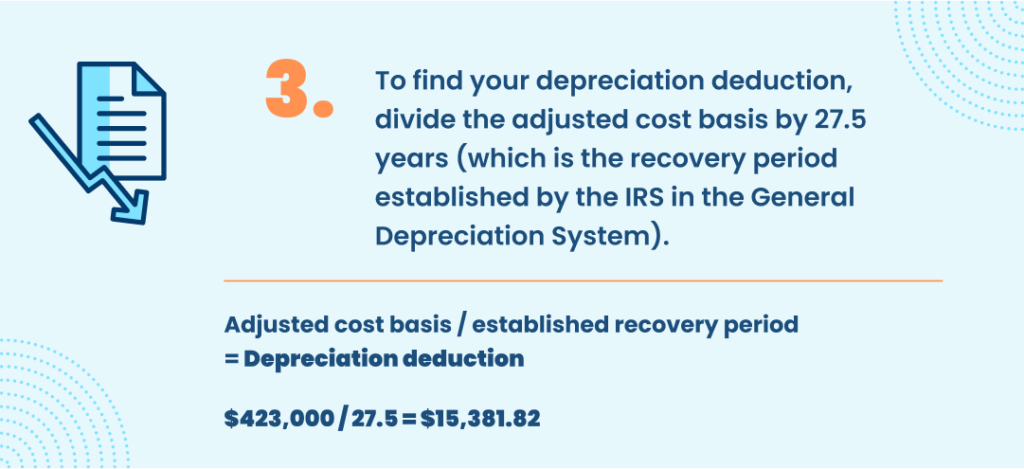
Say the appraiser values the land at $40,000. If using GDS, subtract $40,000 from the cost of acquiring and renovating the property ($463,000) and divide it by 27.5 years.
For example: $463,000 – $40,000 = $423,000. Divide that by 27.5 years, and you get $15,381.82 which you can now deduct from your annual income. However, for the first year you put the property in service, you’ll consult the MACRS percentage table to calculate the depreciation deduction based on the month you placed the property in service.
According to the percentage table, if you put the property in service in July, you’ll depreciate at 1.667%. Here’s the total for the first deduction: $423,000 (cost basis) * 1.667% = $7,051.41. This is because you’re only allowed to claim a half-year worth of depreciation on this first year.
When Depreciation Stops
Once the property changes hands, the 27.5-year clock starts anew. However, there are other circumstances when investors can no longer deduct rental property depreciation from their taxable income.
The first is when the property has fully recovered its cost. That means an investor has deducted the property’s entire cost basis.
The other is when the property no longer generates income. For example, an investor could move into the property, taking it off the rental market altogether and ceasing income generation.
Recapture Considerations and Capital Gains
While depreciating properties comes with substantial tax deductions, you must pay some back via recapture taxes, which the IRS levies at tax time each year after the year of sale. Also, if you don’t plan on reinvesting your gains via a 1031 exchange, you’ll have to pay capital gains tax.
Let’s look at an example to see how the numbers work out.
Assume you purchased the property above six years ago and sold it at the end of the sixth year for $700,000. In our example, we determined the property had a cost basis of $423,000. Because you sold the property after six years, the depreciation deductions you’ve taken amount to $92,290.92. Now, you’ll have the figures necessary to calculate the property’s adjusted basis.
To calculate that amount, subtract the $92,290.91 in accumulated depreciation deductions you’ve claimed on your taxes from the original cost basis of $423,000 for a total of $330,709.09. Now, subtract the adjusted cost basis from the sales amount of $700,000 ($700,000 – $330,709.09 = $369,290.91).
Of that $369,290.91, $92,290.91 is taxed at your ordinary income tax rate, which is not to exceed 25% as outlined in the Tax Cuts and Jobs Act. The remaining $277,000 is then taxed at your long-term capital gains tax rate of 0%, 15%, or 20%.
Long story short, while investors benefit from tax reductions during their property ownership, it’s vital to account for recapture and capital gains taxes to understand your finances following the sale of a property.
How TurboTenant’s REI Hub Integration Simplifies Accounting
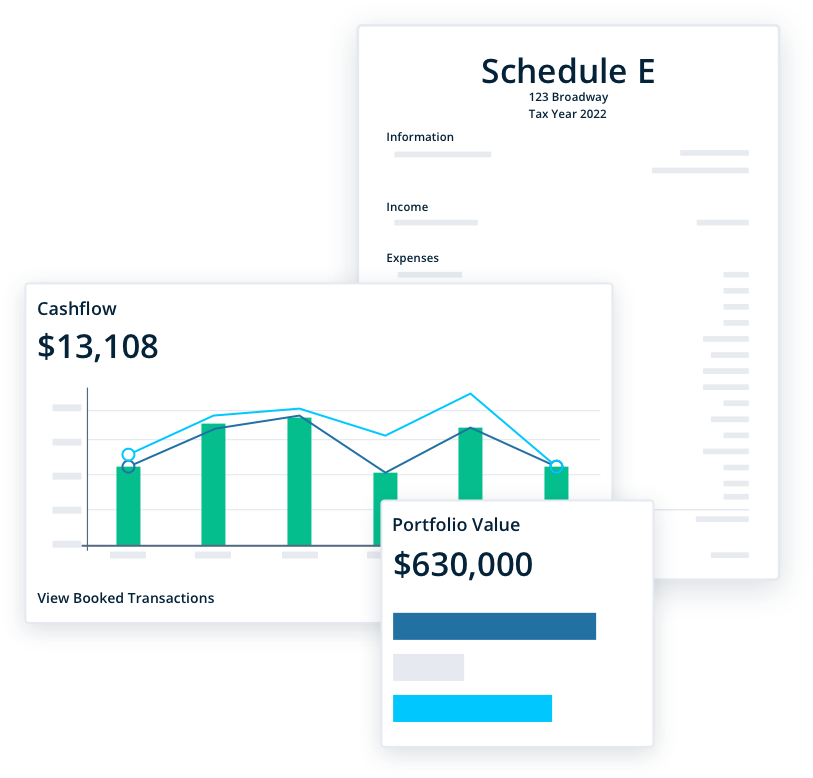
Getting your accounting processes organized ahead of tax time can alleviate stress when the deadline comes around. Thanks to TurboTenant’s automated bookkeeping software integration with REI Hub, you can simplify the accounting process for your rental property depreciation deductions while keeping track of expenses like repairs and rental upgrades.
But expenses and deductions are just one part of the equation. With tailor-made accounting software for landlords and real estate investors, REI Hub provides a birds-eye view of all your finances — in one easy-to-find location.
Sign up today for a TurboTenant account and start the process of automating your accounting processes while modernizing property management tasks.







